Article MT221
Southrepps
singing and step dancing in a north Norfolk village
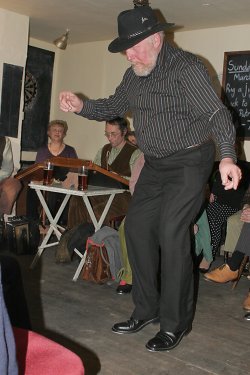 Southrepps is a large, spread out village in north Norfolk, a couple of miles inland from the coastal town of Cromer. This particular area has a rich history of traditional music making, with Cromer as the centre, it spreading to a great many surrounding villages. The area has been linked particularly with step dancing; a tradition still carried on today by the Davies family of fishermen and lifeboatmen. It was assumed until fairly recently, by many interested in these traditions, that step dancing in East Anglia was mainly the preserve of coastal districts, with fishermen being the main exponents, but further research and evidence has proven step dancing to be just as prevalent inland as it was by the sea. In fact, today, this tradition is perhaps flourishing most of all in the Waveney valley area of the Norfolk / Suffolk border, and not particularly close to the sea. Be that as it may, Cromer and its surrounding area has a long standing tradition of music making, with more than its share of renowned singers, musicians and step dancers.
Southrepps is a large, spread out village in north Norfolk, a couple of miles inland from the coastal town of Cromer. This particular area has a rich history of traditional music making, with Cromer as the centre, it spreading to a great many surrounding villages. The area has been linked particularly with step dancing; a tradition still carried on today by the Davies family of fishermen and lifeboatmen. It was assumed until fairly recently, by many interested in these traditions, that step dancing in East Anglia was mainly the preserve of coastal districts, with fishermen being the main exponents, but further research and evidence has proven step dancing to be just as prevalent inland as it was by the sea. In fact, today, this tradition is perhaps flourishing most of all in the Waveney valley area of the Norfolk / Suffolk border, and not particularly close to the sea. Be that as it may, Cromer and its surrounding area has a long standing tradition of music making, with more than its share of renowned singers, musicians and step dancers.
In 1952 Peter Kennedy came to the area to record what he could find of traditional music making for the BBC. His expedition yielded him recordings of singing and melodeon playing in Cromer from Percy Brown 1, Neville Grout and Bob Thompson, and step dancing from Henry 'Shrimp' Davies.
1, Neville Grout and Bob Thompson, and step dancing from Henry 'Shrimp' Davies. 2 Further along the coast he also recorded country dance tunes from Herbert Smith of Blakeney
2 Further along the coast he also recorded country dance tunes from Herbert Smith of Blakeney 3 and Ann Mary Bullimore of Morston, as well as songs from Billy Dickerson and Phil Hamond of Morston
3 and Ann Mary Bullimore of Morston, as well as songs from Billy Dickerson and Phil Hamond of Morston 4 and Alfred Barker of Burgh-next-Aylsham. I strongly suspect that he was given a few contacts by Norwich music teacher and country dance enthusiast Joan Roe, through the English Folk Song and Dance Society, as she had noted down songs and tunes from several of these performers in the 1930s. This seems to have been Kennedy's only trip to collect traditional music in Norfolk.
4 and Alfred Barker of Burgh-next-Aylsham. I strongly suspect that he was given a few contacts by Norwich music teacher and country dance enthusiast Joan Roe, through the English Folk Song and Dance Society, as she had noted down songs and tunes from several of these performers in the 1930s. This seems to have been Kennedy's only trip to collect traditional music in Norfolk.
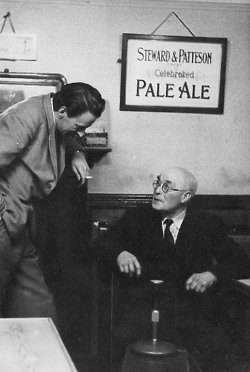 His place was taken by Seamus Ennis, newly arrived in England in 1951, to work for the BBC collecting traditional music and song, with radio producer Brian George. This work continued until 1958 and Ennis' return to Ireland. Seamus Ennis seems to have arrived in Norfolk in 1953, according to the brief inlay notes that accompany the CDRs of these recordings which were released until recently on the Folktrax label. He is credited with recording singer Billy Lown of Cley
His place was taken by Seamus Ennis, newly arrived in England in 1951, to work for the BBC collecting traditional music and song, with radio producer Brian George. This work continued until 1958 and Ennis' return to Ireland. Seamus Ennis seems to have arrived in Norfolk in 1953, according to the brief inlay notes that accompany the CDRs of these recordings which were released until recently on the Folktrax label. He is credited with recording singer Billy Lown of Cley 5 in that year, but all other work seems to have been in Southrepps, according to the available recordings of this material.
5 in that year, but all other work seems to have been in Southrepps, according to the available recordings of this material.
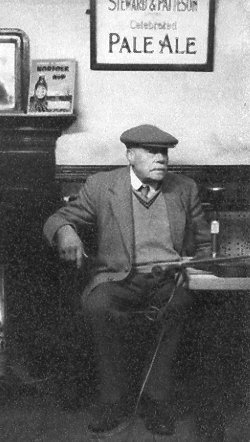 Music making in Southrepps took place mainly in the village's pub, The Vernon Arms. The landlord was Ben Baxter, who took over the pub on Christmas Eve, 1934, and who held the licence until July, 1958. He was a fine singer who provided Seamus Ennis with much material, mainly fragments of songs. His brother Harry played the fiddle and also sang (Blow the Candle Out). The Baxter brothers were, according to the brief notes with the CDR of their songs, the first people Ennis recorded in England: 'These two brothers were the first informants encountered by Seamus Ennis on a recording trip to Southrepps in Norfolk in 1955. Ben, aged 83, was the main singer and his brother Harry occasionally prompted him. Together they sang the Scarborough-drowning tragedy. After Seamus had returned to London, Ben would remember more songs and verses and in the end Seamus returned three times.'
Music making in Southrepps took place mainly in the village's pub, The Vernon Arms. The landlord was Ben Baxter, who took over the pub on Christmas Eve, 1934, and who held the licence until July, 1958. He was a fine singer who provided Seamus Ennis with much material, mainly fragments of songs. His brother Harry played the fiddle and also sang (Blow the Candle Out). The Baxter brothers were, according to the brief notes with the CDR of their songs, the first people Ennis recorded in England: 'These two brothers were the first informants encountered by Seamus Ennis on a recording trip to Southrepps in Norfolk in 1955. Ben, aged 83, was the main singer and his brother Harry occasionally prompted him. Together they sang the Scarborough-drowning tragedy. After Seamus had returned to London, Ben would remember more songs and verses and in the end Seamus returned three times.' 6
6
Of these songs and fragments, quite a few have surfaced on Folktrax CDRs and these give a good idea of the wide range of songs Ben Baxter in particular would sing, albeit often in fragmentary versions by the time he was recorded by Ennis in the mid 1950s:
| Ben Baxter:
|
As I Walked Out
The Bailiff's Daughter of Islington
The Barley Straw
The Black Velvet Band
Caroline and her Young Sailor Bold
The Cruel Mother
The Derby Ram
Died For Love
The Factory Girl
The Flower Show
Sir Rowley (the Frog and the Mouse)
The Gypsy Girl
The Gypsies' Glee
The Herring Song
The Hot Ashpelt
|
If I Were a Blackbird
The London Merchant
Lord Bateman
O, Where are you Going?
The Outlandish Knight
The Penny Wager
The Poor Old Man
The Roving Kind
Scarborough (with Harry Baxter)
The Seamen's Alphabet
Stick, Stick, Beat the Dog (story)
Sweet Smelling Lavender
The Twelve Apostles
The Two Jolly Butchers
Ye Gentlemen of England
|
| Harry Baxter:
|
Blow the Candle Out  7 7
|
A great many of these songs are common enough, although not necessarily found regularly in East Anglia, but a few are very uncommon indeed, such as the lengthy The Twelve Apostles and The Flower Show, extolling the virtues of various Nineteenth Century politicians and other figures, with reference to the various parts of Britain. Ben Baxter was evidently a singer with a considerable and sometimes unusual repertoire, even if his memory was failing by the time he met Seamus Ennis. Where he got the songs from is unknown; he just makes the comment when recording a fragment of O Where are you Going? that, "My uncle, he used to sing to us boys, just one verse of this song; and that very rarely and very occasional … That's all I remember of it, but I just remember it and have a faint idea he used to sing the song, really, but I can't remember it."
In Southrepps Ennis also came across Leslie Lawson, who sang The Dolphin and played a very sprightly Yarmouth Hornpipe on the mouth organ, Sid Load, who sang The Farmer's Servant, and Leslie Bane, who sang The Dark-eyed Sailor and The Faithful Sailor Boy. 8 At least, these men were recorded in Southrepps according to the brief CDR inlay notes. Leslie Bane, according to former village resident Ken Walpole, "came from a big Southrepps family. He has now passed over (2004). There aren't many of us Sudruppians left." Sid Load seems to have hailed from Worstead and Leslie Lawson was recorded in Walcott, a little further down the coast, by Neil Lanham in the 1960s.
8 At least, these men were recorded in Southrepps according to the brief CDR inlay notes. Leslie Bane, according to former village resident Ken Walpole, "came from a big Southrepps family. He has now passed over (2004). There aren't many of us Sudruppians left." Sid Load seems to have hailed from Worstead and Leslie Lawson was recorded in Walcott, a little further down the coast, by Neil Lanham in the 1960s. 9
9
A letter to the January and February, 1968, edition of Norfolk Fair, by Reginald Gamble of Cromer, in reply to an article in a previous edition of the magazine called The Vanishing Folk-dances of Norfolk, referring to step dancing, says, 'It is still most expertly performed by 'Shrimp' Davies, and his brother Bob, while their uncle Jack was considered a past master of the art. Even today, and despite his advanced age, he will 'tap the toe' on occasion.
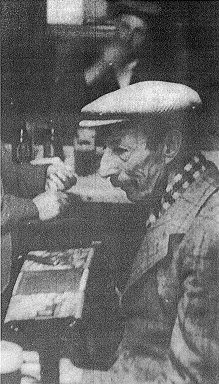 It is not a spectacular dance for, apart from the very slight movement of the feet, there is virtually no body movement. It is performed solely on the ball of the foot, whereas in normal tap dancing the heel is brought into play. It has been my great joy to see it performed at The Vernon Arms, Southrepps, in the days of the late Ben and Harry Baxter, by 'Shrimp' and Bob Davies, accompanied on the fiddle by Harry Baxter.'
It is not a spectacular dance for, apart from the very slight movement of the feet, there is virtually no body movement. It is performed solely on the ball of the foot, whereas in normal tap dancing the heel is brought into play. It has been my great joy to see it performed at The Vernon Arms, Southrepps, in the days of the late Ben and Harry Baxter, by 'Shrimp' and Bob Davies, accompanied on the fiddle by Harry Baxter.'
Harry Baxter was not the only musician to play for step dancing in the pub. Albert Hewitt (c.1880-1960), who played one-row melodeon and was recorded by Seamus Ennis playing Sheringham Breakdown and Southrepps Hornpipe, 10 was a regular musician. He and his wife Christina, who were cousins, came from a large Irish gypsy family. Their granddaughter Carole Longhorn cannot recall whether it was Albert or his parents who actually came over from Ireland to settle in Norfolk, but he was certainly in Southrepps at the turn of the Twentieth Century, being listed in the 1901 census as 'Albert Bane, age 21, general labourer', here using an alternative part of his surname, as his actual full name was Albert Hewitt-Bane. Christina would step dance, as remembered by Carole Longhorn, "They were Romany Gypsies. That's where the music came from. But granddad played the accordion and nan, she was the dancer. She would step dance. She would go on to Cromer and dance on the table." The Hewitts had a market gardening business and taking the produce to nearby Cromer brought them into the lively music making there, as remembered by grandson Peter Hewitt, "Well, my grandmother used to do step dancing in Cromer, 'cause my grandfather had a market … he used to be vermin control at Gunton Hall, and in the meantime he used to grow vegetables and such like, and he had a little market garden place on the edge of the road as you turn up towards Southrepps, and anyway, my grandmother and them used to sell all the wares at Cromer, and cause I don't know whether they come back with much money, cause she used to get on the table and used to dance and used to have a good drink, y'know; and she used to dance and step, and my grandfather used to play the accordion in the pubs."
10 was a regular musician. He and his wife Christina, who were cousins, came from a large Irish gypsy family. Their granddaughter Carole Longhorn cannot recall whether it was Albert or his parents who actually came over from Ireland to settle in Norfolk, but he was certainly in Southrepps at the turn of the Twentieth Century, being listed in the 1901 census as 'Albert Bane, age 21, general labourer', here using an alternative part of his surname, as his actual full name was Albert Hewitt-Bane. Christina would step dance, as remembered by Carole Longhorn, "They were Romany Gypsies. That's where the music came from. But granddad played the accordion and nan, she was the dancer. She would step dance. She would go on to Cromer and dance on the table." The Hewitts had a market gardening business and taking the produce to nearby Cromer brought them into the lively music making there, as remembered by grandson Peter Hewitt, "Well, my grandmother used to do step dancing in Cromer, 'cause my grandfather had a market … he used to be vermin control at Gunton Hall, and in the meantime he used to grow vegetables and such like, and he had a little market garden place on the edge of the road as you turn up towards Southrepps, and anyway, my grandmother and them used to sell all the wares at Cromer, and cause I don't know whether they come back with much money, cause she used to get on the table and used to dance and used to have a good drink, y'know; and she used to dance and step, and my grandfather used to play the accordion in the pubs." 11
11
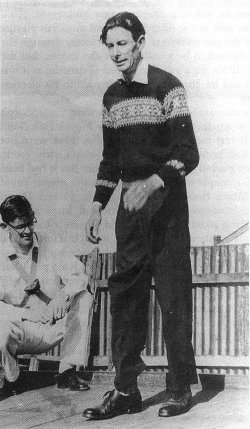 Albert and Christina's son Dick picked up step dancing from his mother. Born in 1922 in the neighbouring village of Hanworth, he lived his early life in Southrepps and was another regular in The Vernon Arms, as remembered by Mr R Hurn of Banningham, "He was often seen tap dancing on a tray on a table in The Vernon Arms and lived in cottages close by." During the war he was an army bandsman, captured by the Japanese, and spent several harrowing years in prisoner-of-war camps. By the early 1950s he was still recovering from his ordeal, as is evident in the photograph of him step dancing at Southrepps recreation ground in about 1953. Dick Hewitt moved away from the village in 1965 to become landlord of Briston Horseshoes. For ten years this pub became widely known as a place for music and step dancing and Dick himself became one of the best known and highly regarded step dancers in England.
Albert and Christina's son Dick picked up step dancing from his mother. Born in 1922 in the neighbouring village of Hanworth, he lived his early life in Southrepps and was another regular in The Vernon Arms, as remembered by Mr R Hurn of Banningham, "He was often seen tap dancing on a tray on a table in The Vernon Arms and lived in cottages close by." During the war he was an army bandsman, captured by the Japanese, and spent several harrowing years in prisoner-of-war camps. By the early 1950s he was still recovering from his ordeal, as is evident in the photograph of him step dancing at Southrepps recreation ground in about 1953. Dick Hewitt moved away from the village in 1965 to become landlord of Briston Horseshoes. For ten years this pub became widely known as a place for music and step dancing and Dick himself became one of the best known and highly regarded step dancers in England.
One main purpose of these collecting trips was to provide material for the BBC radio programme As I Roved Out. This ran from 1953 until 1958, featuring traditional song and music from around the British Isles and Ireland, being broadcast on Sundays. One programme in particular, broadcast on 2nd January, 1955, comprised music from Norfolk and featured some of Seamus Ennis' recordings from Southrepps. Ken Walpole recalled: "I was brought up in a house opposite The Vernon Arms in Southrepps. I was not a 'pub person' at the time, so I rarely went in the place. However, when I lived in west Norfolk I was listening to the wireless one Sunday morning about 1954/5 and I heard a programme of music and dancing from The Vernon. Ben Baxter, the landlord, sang a song about the Maids of Australia, Dick Hewitt did his shuffle/tap dancing, and Les Bane sang."
Unfortunately the copy of the programme I have managed to get hold of 12 is missing some minutes at the beginning of the broadcast. Ben Baxter may well have sung The Maid of Australia towards the beginning of the programme, but sadly this is missing from the extant recording. Of the rest, it is divided into two parts, the first presented by Seamus Ennis and featuring recordings from Southrepps, and the second by Peter Kennedy and another man I have been unable to identify, although he was certainly a local man, and featuring other recordings from Norfolk.
12 is missing some minutes at the beginning of the broadcast. Ben Baxter may well have sung The Maid of Australia towards the beginning of the programme, but sadly this is missing from the extant recording. Of the rest, it is divided into two parts, the first presented by Seamus Ennis and featuring recordings from Southrepps, and the second by Peter Kennedy and another man I have been unable to identify, although he was certainly a local man, and featuring other recordings from Norfolk.
Based on the recording I have, the programme comprised the following:
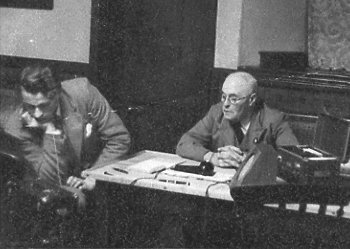 All of these were introduced by Seamus Ennis, giving brief comments about what he found in Southrepps, finding many similarities with the traditional music of his native Ireland, and suggesting that the livestock trade from Ireland to Norfolk was responsible for a two-way traffic in music and song. Of the songs, all but The Devil Song were excerpts only.
All of these were introduced by Seamus Ennis, giving brief comments about what he found in Southrepps, finding many similarities with the traditional music of his native Ireland, and suggesting that the livestock trade from Ireland to Norfolk was responsible for a two-way traffic in music and song. Of the songs, all but The Devil Song were excerpts only.
Then, in the second part, the unidentified presenter talked about meeting Sid Load in Worstead, before the latter sings a snatch of The Farmer's Servant. This is followed by an excerpt of a dance band playing The Thing (with vocal), which uses the same tune as the traditional song, and then we hear Sid Load singing the last verse of The Farmer's Servant himself.
Peter Kennedy then plays Perfect Cure / Starry Night For a Ramble (melodeon), which he wrongly claims that he got from Blakeney fiddler Herbert Smith 13
13
Herbert Smith talks about country dancing: "And they'd have a dinner and refreshments, and all that kind of thing. Then they would start off with the good old country dance, like Haste to the Wedding or Pop Go the Weasel, or Tommy, Make Room for your Uncle; you could play either them three tunes and they'd; most of the company, they thought they had a little whim which tune they; some preferred one and some the other. And sometimes they have about seventy couple up, and you have to play them round. By the time you got; played them round; that take twenty minutes. They'd be a good bit exhausted; they'd want a bit of a rest, so they'd have a; fit in a song in between."
Phil Hamond then sings The Candlelight Fisherman and Harry Cox sings As I Walked Out (excerpt); both these songs introduced by Peter Kennedy.
Then Peter Kennedy plays Four Hand Reel (melodeon), which he erroneously claims that people in Norfolk would know as Yarmouth Hornpipe. 14
14
The BBC recording trips and the resultant broadcast are remembered by very few in Southrepps and the surrounding area now. For a couple of years at least, the BBC, in the form of Irishman Seamus Ennis - himself a superb musician, singer and storyteller - took pains to record what was undoubtedly then a lively tradition of song and step dancing, at a time just before this was beginning to diminish in the village and the surrounding area.
Chris Holderness - 22.01.09
Rig-a-Jig-Jig: A Norfolk Music History Project
Notes:
1. See Musical Traditions article MT211: Percy Brown: Aylsham Melodeon Player.
2. Most of the performers mentioned in this paragraph can be heard on Folktrax CDR Ftx 328: Norfolk Village Songs and Dances.
3. See Musical Traditions article MT179: Herbert Smith: Fiddling Blacksmith of Blakeney.
4. See Musical Traditions article MT198: Billy Lown and Phil Hamond: two North Norfolk Singers.
5. See MT198, as above.
6. These songs can be heard on Folktrax CDR Ftx 234: Ben and Harry Baxter: As I Walked Out; Songs from Norfolk. The date given for all recordings is 1955, but surely some were made in the previous year, as the broadcast was only two days into that year.
7. This song can be heard on Ftx 328, as above.
8. All of these can be heard on Ftx 328, as above.
9. NLCD6: East Coast Fishermen - he sings an excerpt of Windy Old Weather and plays Yarmouth Hornpipe on the mouthorgan.
10. Both can be heard on Ftx 328, as above. He is the only one to have been recorded playing Southrepps Hornpipe. Whether he gave the tune this name is unknown.
11. Interviewed by Keith Skipper on BBC Radio Norfolk for the programme 'Dick Hewitt - A True Norfolk Man' on 4.11.1994.
12. From the Russell Wortley Collection in the National Sound Archive, London. The CDR was transferred from reel-to-reel tape, and was presumably recorded from the radio by Russell Wortley himself.
13. If Herbert Smith played The Perfect Cure to Peter Kennedy, then no recording has come to light. He did play Starry Night for Kennedy, but this is a substantially different version to the one played here. In fact the two tunes as played by Peter Kennedy here were the standard EFDSS versions made popular by Joan Roe. She noted The Perfect Cure from Herbert Mallett of Aldborough, Norfolk, in 1935 and was given the notation of Starry Night by a Mrs Gay, who noted it from a Mr Newstead in Wickmere, Norfolk, in 1932.
14. The Four Hand Reel, used as a step dance tune, was often called Sheringham Breakdown by local musicians. Very frequently only the A music was played. In fact, Albert Hewitt had already played a version earlier in the broadcast! The tune has no similarity to Yarmouth Hornpipe.
The photograph of Richard Davies was taken by Chris Gill and the photographs of recording in The Vernon Arms were provided by Sally Purdey of Southrepps.
Article MT221
Site designed and maintained by Musical Traditions Web Services Updated: 27.1.09
 Southrepps is a large, spread out village in north Norfolk, a couple of miles inland from the coastal town of Cromer. This particular area has a rich history of traditional music making, with Cromer as the centre, it spreading to a great many surrounding villages. The area has been linked particularly with step dancing; a tradition still carried on today by the Davies family of fishermen and lifeboatmen. It was assumed until fairly recently, by many interested in these traditions, that step dancing in East Anglia was mainly the preserve of coastal districts, with fishermen being the main exponents, but further research and evidence has proven step dancing to be just as prevalent inland as it was by the sea. In fact, today, this tradition is perhaps flourishing most of all in the Waveney valley area of the Norfolk / Suffolk border, and not particularly close to the sea. Be that as it may, Cromer and its surrounding area has a long standing tradition of music making, with more than its share of renowned singers, musicians and step dancers.
Southrepps is a large, spread out village in north Norfolk, a couple of miles inland from the coastal town of Cromer. This particular area has a rich history of traditional music making, with Cromer as the centre, it spreading to a great many surrounding villages. The area has been linked particularly with step dancing; a tradition still carried on today by the Davies family of fishermen and lifeboatmen. It was assumed until fairly recently, by many interested in these traditions, that step dancing in East Anglia was mainly the preserve of coastal districts, with fishermen being the main exponents, but further research and evidence has proven step dancing to be just as prevalent inland as it was by the sea. In fact, today, this tradition is perhaps flourishing most of all in the Waveney valley area of the Norfolk / Suffolk border, and not particularly close to the sea. Be that as it may, Cromer and its surrounding area has a long standing tradition of music making, with more than its share of renowned singers, musicians and step dancers.
 His place was taken by Seamus Ennis, newly arrived in England in 1951, to work for the BBC collecting traditional music and song, with radio producer Brian George. This work continued until 1958 and Ennis' return to Ireland. Seamus Ennis seems to have arrived in Norfolk in 1953, according to the brief inlay notes that accompany the CDRs of these recordings which were released until recently on the Folktrax label. He is credited with recording singer Billy Lown of Cley
His place was taken by Seamus Ennis, newly arrived in England in 1951, to work for the BBC collecting traditional music and song, with radio producer Brian George. This work continued until 1958 and Ennis' return to Ireland. Seamus Ennis seems to have arrived in Norfolk in 1953, according to the brief inlay notes that accompany the CDRs of these recordings which were released until recently on the Folktrax label. He is credited with recording singer Billy Lown of Cley Music making in Southrepps took place mainly in the village's pub, The Vernon Arms. The landlord was Ben Baxter, who took over the pub on Christmas Eve, 1934, and who held the licence until July, 1958. He was a fine singer who provided Seamus Ennis with much material, mainly fragments of songs. His brother Harry played the fiddle and also sang (
Music making in Southrepps took place mainly in the village's pub, The Vernon Arms. The landlord was Ben Baxter, who took over the pub on Christmas Eve, 1934, and who held the licence until July, 1958. He was a fine singer who provided Seamus Ennis with much material, mainly fragments of songs. His brother Harry played the fiddle and also sang ( It is not a spectacular dance for, apart from the very slight movement of the feet, there is virtually no body movement. It is performed solely on the ball of the foot, whereas in normal tap dancing the heel is brought into play. It has been my great joy to see it performed at The Vernon Arms, Southrepps, in the days of the late Ben and Harry Baxter, by 'Shrimp' and Bob Davies, accompanied on the fiddle by Harry Baxter.'
It is not a spectacular dance for, apart from the very slight movement of the feet, there is virtually no body movement. It is performed solely on the ball of the foot, whereas in normal tap dancing the heel is brought into play. It has been my great joy to see it performed at The Vernon Arms, Southrepps, in the days of the late Ben and Harry Baxter, by 'Shrimp' and Bob Davies, accompanied on the fiddle by Harry Baxter.'
 Albert and Christina's son Dick picked up step dancing from his mother. Born in 1922 in the neighbouring village of Hanworth, he lived his early life in Southrepps and was another regular in The Vernon Arms, as remembered by Mr R Hurn of Banningham, "He was often seen tap dancing on a tray on a table in The Vernon Arms and lived in cottages close by." During the war he was an army bandsman, captured by the Japanese, and spent several harrowing years in prisoner-of-war camps. By the early 1950s he was still recovering from his ordeal, as is evident in the photograph of him step dancing at Southrepps recreation ground in about 1953. Dick Hewitt moved away from the village in 1965 to become landlord of Briston Horseshoes. For ten years this pub became widely known as a place for music and step dancing and Dick himself became one of the best known and highly regarded step dancers in England.
Albert and Christina's son Dick picked up step dancing from his mother. Born in 1922 in the neighbouring village of Hanworth, he lived his early life in Southrepps and was another regular in The Vernon Arms, as remembered by Mr R Hurn of Banningham, "He was often seen tap dancing on a tray on a table in The Vernon Arms and lived in cottages close by." During the war he was an army bandsman, captured by the Japanese, and spent several harrowing years in prisoner-of-war camps. By the early 1950s he was still recovering from his ordeal, as is evident in the photograph of him step dancing at Southrepps recreation ground in about 1953. Dick Hewitt moved away from the village in 1965 to become landlord of Briston Horseshoes. For ten years this pub became widely known as a place for music and step dancing and Dick himself became one of the best known and highly regarded step dancers in England.
 All of these were introduced by Seamus Ennis, giving brief comments about what he found in Southrepps, finding many similarities with the traditional music of his native Ireland, and suggesting that the livestock trade from Ireland to Norfolk was responsible for a two-way traffic in music and song. Of the songs, all but The Devil Song were excerpts only.
All of these were introduced by Seamus Ennis, giving brief comments about what he found in Southrepps, finding many similarities with the traditional music of his native Ireland, and suggesting that the livestock trade from Ireland to Norfolk was responsible for a two-way traffic in music and song. Of the songs, all but The Devil Song were excerpts only.